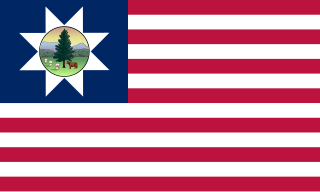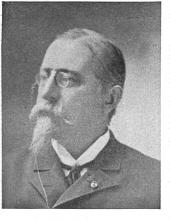
The 7th Vermont Infantry Regiment was a three years' infantry regiment in the Union Army during the American Civil War. It served in the Western Theater, predominantly in Louisiana and Florida, from February 1862 to March 1866. It was the longest serving Vermont regiment during the war.

The Battle of Baton Rouge was a ground and naval battle in the American Civil War fought in East Baton Rouge Parish, Louisiana, on August 5, 1862. The Union victory halted Confederate attempts to recapture the capital city of Louisiana.

The 8th Illinois Infantry Regiment was an infantry regiment that served in the Union Army during the American Civil War.
The 26th Indiana Volunteer Infantry Regiment was an infantry regiment that served in the Union Army during the American Civil War.

Simon Goodell Griffin was a Union Army brigadier general during the American Civil War, farmer, teacher, lawyer and New Hampshire state legislator.

William Plummer Benton was an American lawyer and soldier who served in both the Mexican–American War and the American Civil War, where he would rise to the rank of brigadier general and, in 1866, after his service had ended, would be awarded the brevet grade of major general.

The 9th Regiment Massachusetts Volunteer Infantry was a military unit from Boston, Massachusetts, USA, part of the Army of the Potomac during the American Civil War. It is also known as "The Fighting Ninth". It existed from 1861 to 1864 and participated in several key battles during the war. The unit is an Irish heritage unit, with many volunteers having been born in Ireland.

The New England state of Connecticut played an important role in the American Civil War, providing arms, equipment, technology, funds, supplies, and soldiers for the Union Army and the Union Navy. Several Connecticut politicians played significant roles in the Federal government and helped shape its policies during the war and the Reconstruction.

The 9th New York Infantry Regiment was an infantry regiment that served in the Union Army during the American Civil War. It was also known as the "Hawkins' Zouaves" or the "New York Zouaves."
The 7th Kentucky Infantry Regiment was an infantry regiment that served in the Union Army during the American Civil War.

Isaac Fitzgerald Shepard was a colonel in the Union Army during the American Civil War. His appointment as a brigadier general of volunteers was not confirmed by the United States Senate and expired on July 4, 1864.
The 22nd Kentucky Infantry Regiment was an infantry regiment that served in the Union Army during the American Civil War.
The 42nd Ohio Infantry Regiment was an infantry regiment in the Union Army during the American Civil War.
The 120th Ohio Infantry Regiment, sometimes 120th Ohio Volunteer Infantry was an infantry regiment in the Union Army during the American Civil War. It was commanded by Colonel Daniel French and Colonel Marcus Spiegel.

Charles Augustus Ropes Dimon was a volunteer soldier in the Union Army during the American Civil War. Beginning his service as a private in the 8th Regiment of Massachusetts Volunteer Infantry, Dimon rose through the ranks to become a colonel of a US Volunteer Infantry Regiment and was awarded the honorary grade of brevet brigadier general United States Volunteers, by appointment of President Andrew Johnson on January 13, 1866, to rank from March 13, 1865, and confirmation by the U.S. Senate on March 12, 1866. His success was due in part to the sponsorship of Major General Benjamin F. Butler.
The following list is a Bibliography of American Civil War Union military unit histories. More details on each book are available at WorldCat.
The 8th New Hampshire Infantry Regiment was an infantry regiment that served in the Union Army during the American Civil War.

The 100th Regiment Pennsylvania Volunteer Infantry was an infantry regiment that served in the Union Army during the American Civil War.

The 50th Regiment Massachusetts Volunteer Infantry was a regiment of infantry that served in the Union Army during the American Civil War. It was one of the 18 Massachusetts regiments formed in response to President Abraham Lincoln's August 1862 call for 300,000 men to serve for nine months. The regiment was recruited in Essex County and rendezvoused for mustering in at Camp Edwin M. Stanton in Boxford, Massachusetts. The 50th Massachusetts was assigned to the Department of the Gulf under Major General Nathaniel P. Banks and shipped for Louisiana. The regiment saw combat during the Siege of Port Hudson.

The 4th Louisiana Infantry Regiment was a unit of volunteers recruited in Louisiana that fought in the Confederate States Army during the American Civil War. Formed in May 1861, the regiment served in the Western Theater of the American Civil War. The unit fought at Shiloh and Baton Rouge in 1862 and at Jackson in 1863. A detachment served during the Siege of Port Hudson and was captured. In 1864, the regiment fought in the Atlanta campaign where it lost heavily at Jonesborough. At Nashville in December 1864 most of the men were captured. The survivors were consolidated with several other units and fought at Spanish Fort in April 1865. The remnant surrendered in May 1865.












